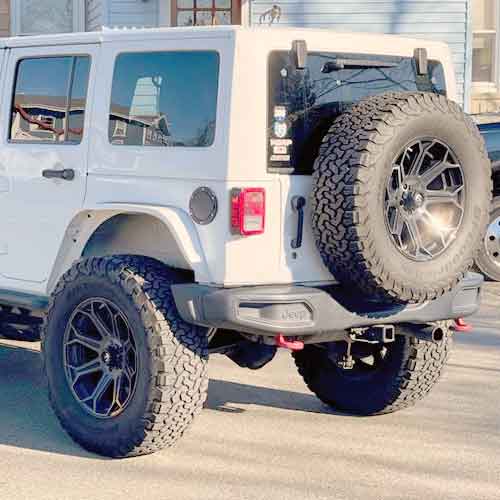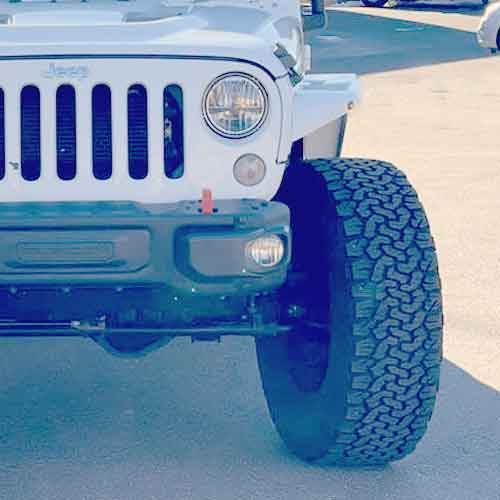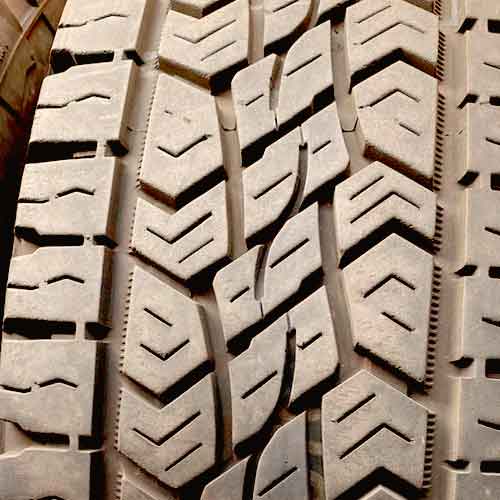While the Continental TerrainContact A/T excels in mild off-road conditions and has superior on-road manners, the BF Goodrich KO2 handles more severe off-road tracks (with more ease thanks to its deep biters) and of course advanced durability. But do you even need that aggressive of a tire? Well let’s find out.

Continental TerrainContact A/T in my opinion (as a tire engineer) bring a more on-road oriented traction. In fact, it’s the best in the business there, that’s why it ranked in my list of all time favorites. The BF Goodrich KO2 promotes its aggressive design with a lot more durable sidewalls. It’s sides are actually powerful form both inside and out, and they bring much more biters which chew on rocks, mud and other types of rugged terrains, including snow. Which reminds me, it’s rated with 3PMSFR unlike the TerrainContact A/T.
Detailed Review of Continental A/T: https://tiredriver.com/continental-terraincontact-at-review/
Detailed Review of BFG KO2: https://tiredriver.com/bf-goodrich-ko2-review/
Sizes Info
Starting with BFG KO2, this tire gives you 90 sizes (more in comparison) going from 15 to 22 inches rim sizes. They have following specs.
- All sizes have M+S and 3PMSF snow ratings.
- Speed Ratings are available in R, S, or Q.
- Load ratings: C to E.
- Weight range: 35 lbs to 67 lbs.
- Tread Depth: 15/32″ on all sizes (except 4) (find all in it’s detailed review).
- 50k miles warranty.
The Continental TerrainContact AT, on the other side, comes in a total of 38 sizes, in 16 to 20 inches, with following specs.
- Speed rating: S, T, H and even V is seen on one size (255/55/R19).
- Load ratings: SL to E.
- Weight range: 28 to 66.5 lbs.
- Tread depth range: LT sizes have 16/32″, where no LT come in 12/32″ (also, one size is also seen with 10/32″ as well).
- These sizes don’t offer any winter ratings.
- They come with 60k miles warranty.
Durability
In case of Continental TerrainContact, the tire offers 2 ply polyester casing, which is covered with 2 steel belts and a spirally wound nylon (1 layer).
So the tire is weaker from both middle, as well as sidewalls, comparatively, as the BFG KO2 gives you “3” ply polyester cover, 2 belts and “2” ply “spirally wound” nylon covering.
This construction, makes it the toughest tire in A/T category.
Tread Design
The BF Goodrich KO2 forms a very uniform design in the middle.

It carries 3 ribs there, where the middle lugs gets wrapped with other surrounding two, forming a very interlocked pattern of grooves.
All these blocks have full depth sipes, which allow these lugs to further open and close up, promoting off-road bite.
On the outer circumferential grooves, they make they also embedded with “triangular shaped” stone ejectors, which yields great self cleaning (though it’s interconnected map of grooves invite a lot of dirt, still).
Moving towards shoulders, they are slightly bigger, and should I add, much more aggressive.
They have full depth traction notches in them, of various shapes, and towards outer edges, they make staggered design.
They also join together on sidewalls, and make slanted lugs there, with sharp biters in between (which help a lot with traction, and footprint, with lowered air pressure).
On the other side, the Continental TerrainContact A/T has a very on-road oriented design with five ribs in a closed up structure.

On the outer ribs, the shoulder lugs have a squared-off structure with deep full depth interlocking sipes.
All of these lugs are joined together by connectors/ridges to improve lateral traction.
In the middle, there are three ribs, with the central one having a wave-like structure, and wider blocks, that aid in directional traction.
They have curved notches, rectilinear sipes, and foundational supports of secondary rubber layers.
The surrounding ribs have similar siping patterns, and also feature sharp teeth facing the shoulders (called snow vices).
All of these lugs also have secondary rubber layers underneath, that connect with the shoulder lugs, and this adds to the lateral traction further.
Dry Performance
There are several elements that contribute to optimal “dry” performance on highways, including grip, cornering stability, and steering feedback.
Dry grip refers to the tire’s ability to adhere to the road surface when moving on a straighter path, while handling stability refers to how well the tire maintains its position on the road during turns and other maneuvers.
Lastly, steering feedback refers to the tire’s responsiveness to steering inputs.
I’ve discussed how both these boys performed in all of them below.
Directional Grip
All-terrain A/T tires may struggle with dry traction due to their bold design, which does not always provide a “secure-enough” grip on pavements, though with a more on-road design, they do a lot better.
So this means more aggressive the tire gets, the more limited the grip gets.
It makes sense, because the Continental TerrainContact A/T with it’s streamlined design constituting of 3 ribs in the middle/ offers a far superior contact with the ground, and this results in superior grip, or should I say directional grip.
Basically directional grip is a result of how much central lugs meet up with the road. (I should also add that they also have to be firm too).
BF Goodrich KO2 although has a stiffer composition that is desirable on dry roads, it’s wider tread voids eat away a lot of contact (which could have met with the surface). So it shows up with longer braking distances and acceleration times (a measurement of grip).
Dry Handling
Continental TerrainContact has pretty packed up shoulder lugs and they offers much smoother and better lateral traction, in fact, out of all the other A/T tires I’ve reviewed, it comes on top.
But why shoulders? Well, that’s because as the tire turn, it’s weight is emphasized on the edges, aka shoulder lugs. So these lugs get to meet up with the road with more “friction”, and how much rubber is there, or you can say, how consistent is the meet up there, decides the overall handling performance.
BF Goodrich KO2 has very aggressive shoulder lugs with huge gaps in between, and it’s lugs are eaten away with different kinds of notches and siping.
So with less rubber left there, the tire is not able to provide as good of a result as its competitor.
The Continental A/T on the other side, not only offers smaller tread voids there, all it’s lugs are also joined together form secondary layer running underneath. So with that, it gets to have enhanced lateral stability along with powerful lateral g forces.
Steering Response
The compound stiffness and tread design of a tire can significantly impact its steering response.
Continental TerrainContact AT is offering both, and that’s the reason why it provides you with speed ratings up to H, whereas the BFG KO2 with it’s aggressive pattern can only go up to S.
It’s lugs make a firmer contact with the road, form both the middle and sides, and their consistent connection with the road ensure faster response to even slight input variations (from the steering wheel).
Wet Traction
The compound stiffness and sipe density determine the overall grip on wet, and here the Continental TerrainContact A/T offers both, that’s why it shows up with better results in comparison.
This tire is basically one of the least aggressive A/Ts, that you can get, with it’s primary focus on highway’s performance. And so its not surprising that it’s wet traction is also one of the top tier, just like its grip on dry.
The BF Goodrich KO2 in comparison, although offers decent water removal through grooves, (providing ample hydroplaning resistance), it’s siping is pretty stiff and don’t produce as satisfactory feedback, as needed.
The tire also has dual compound composition, where the harder rubber underneath which comes out with wear, limits wet traction further.
Fuel and Tread Life
Fuel is what makes the energy, which then gets used up to roll the tire, so tires having more “resistance” to rolling aren’t efficient, and out of both, the BF Goodrich KO2 is in that list.
Basically, KO2 has more weight and a balder design. So each of its blocks bears more pressure on it, and burns off with the road, with greater force, eating away more fuel as a result.
Though, the tire’s stiffer composition does not make it a lot more susceptible to wearing off quickly.
On the other side, the Continental TerrainContact AT with it’s streamlined design and lighter structural weight offers a lot better resistance to wear and shows up with better fuel economy.
Though compared to other “on-road A/Ts”, its not that impressive.
Winter Traction
Although both tires offer you with all-season traction, only the BF Goodrich KO2 is the one with 3 peak mountain snowflake rating.
The tire basically offers an interlocking design which is pretty great at lodging snow particles in its grooves and making snow to snow contact.
This contact is basically very needed, as rubber to snow only yields slippage.
In comparison, the Continental A/T takes a back seat here, as it’s tread is not thermal-adaptive. And so with extreme winter temperatures, it’s sipes (which are already not optimized for snow), get to freeze up, compromising on traction further.
Off Road
Off-road I’ve experienced these tires on the following terrains. Starting off with the most aggressive of all.
Mud
Though both tires are not good for mud, the BF Goodrich KO2 is still able to keep it’s grooves cleaner, especially from the shoulders, where it’s pretty bald.
The Continental TerrainContact AT on the other side, is pretty crowded with lugs, and can not handle even a little bit of mud, with it’s less voided design. So it’s wise not to take these tires on even mild off-road muddy tracks.
(Though compared to other aggressive options, BFG KO2 lacks as well with it’s interconnected central grooves, which invite a lot mud to settle in).
Sand
Out of both tires, the Continental TerrainContact AT with smoother edges, and lighter structural weight its less prone to dig in.
And that makes it a lot more better, because digging is the worse enemy of sand traction.
Moreover, on this tire, you also get to have elongated lugs, that offer decent paddling, though the tire could have really used some sidewall lugs here (which are missing).
BF Goodrich KO2 on the other hand, suffers in this area, with its extremely biting shoulders.
Basically with stiffer inner construction, mainly because of 3 ply spirally wound nylon cap plies, it simply “digs” in more, and makes it very difficult to move ahead, especially on slopes (even with it’s thicker sidewall lugs, and strong rim locks, which allows it to run with extremely low air pressure).
Rocks
Rocky terrains require tires to be durable, especially from the sidewalls, both from inside and out.
With missing biters, especially on shoulders (and of course, sidewalls), there isn’t enough lateral traction on Continental TerrainContact.
Whereas the BF Goodrich KO2 with it’s 3 ply powerful sides, and thick lugs, notches, staggered shoulders works like a champ.
You might say it rocks on rocks.
I really like the fact that how it’s full depth siping simply split open (the lugs), and provide extra chewing power when needed, offering grip in nearly all angles.
Gravel
Continental TerrainContact AT with missing stone ejectors lacks on this terrain as well, though being the lightest of all, you can still run these tires there as they come up with cut-resistant rubber.
In comparison, BF Goodrich KO2 has 2 different types of stone ejectors, and so it lasts much longer even with higher speeds there.
For your info: KO2 actually provides two different types of these ejectors, where the triangular ones can be found in the outer circumferential channels, and conventional ones are of course between every shoulder block.
Conclusion
Out of both tires, its pretty obvious why Continental TerrainContact, being one of the least aggressive tire, does a better job on highways, in both wet and dry conditions.
Though it’s winter traction could have made it a better all-season tire, though its missing with 3 peak mountain snowflake rating.
BF Goodrich KO2 on the other hand, does so much better off-road, though still on sand it lacks to it’s competitor. I’ve explained why over there.